Canadian spruce Konica - planting and care in the open field: basic rules for growing
Now there are more and more people who want to have the Canadian Glauka Konik spruce on their site, closer to home. Including very many people want to save a small spruce tree, which was presented to them for the New Year in a pot.
However, in order for the plant to initially have everything it needs for proper growth and development, it is assumed that a number of features will be observed in planting and caring for Konica in the open field.
Note! If you bought Konika in a pot in November-December, or you got it for the New Year, then you will most likely find it useful this material is about caring for spruce at home.
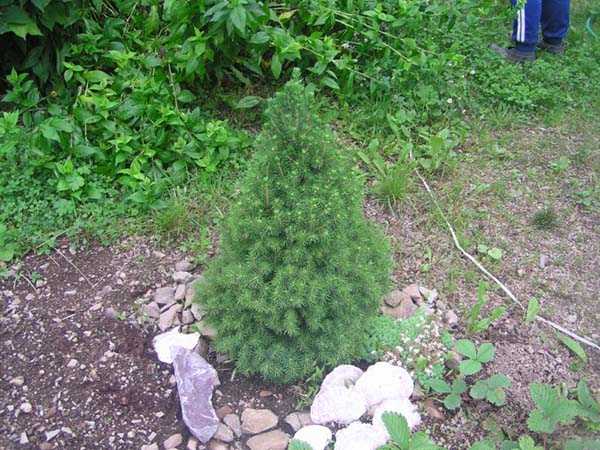
Content
- 1 Canadian spruce Conica (Picea glauca Conica): description
- 2 Konik spruce in landscape design
- 3 When to plant (transplant) Canadian Konik spruce in open ground: optimal timing
- 4 Planting Canadian Konik spruce in open ground
- 5 Features of transplanting Koniki spruce into open ground, bought or donated for the New Year
- 6 How to care for Canadian Konica spruce outdoors
Canadian spruce Conica (Picea glauca Conica): description
Canadian spruce Conica (Picea glauca Conica) - This is an ornamental dwarf coniferous plant with a regular conical (conical) crown shape.
Worth knowing! When you buy a very small young seedling, it does not have a conical shape and its needles are quite rare. But withevery year Konica will become denser and with time it will acquire the necessary conical shape!
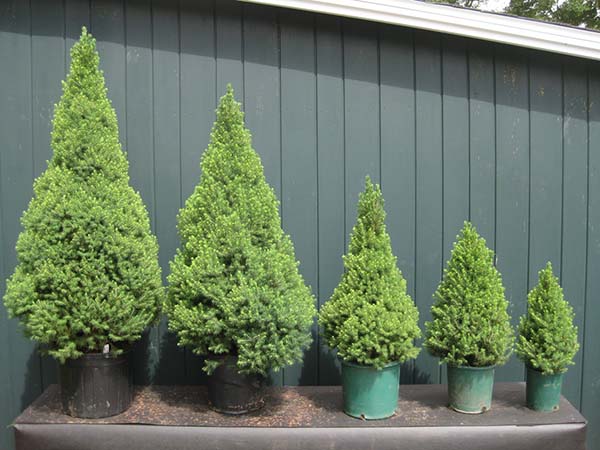
Key characteristics of Canadian Konica spruce:
A distinctive feature of Koniki is that she has a very dense crown, i.e. its short branches are so densely spaced together that there is practically no gap between them (the trunk is not visible).
- Needles - soft, short (up to 9 mm), green.
- Flowering and fruits - blooms in late spring, after which fruits are formed - cones, which become brown during ripening, their length is 3-6 cm.
- Annual growth in height - 4-10 cm, width - 3-5 cm.
Note! If you decide to grow Konica at home, then you should know that it will give a maximum of 4-5 cm of annual growth.
- Maximum height - 3-4 meters with a crown diameter (width) of 2 meters.
Interesting! According to experimental data, at the age of 10 years, the Canadian Konica spruce reaches a height of 1 meter, at 35 years old, some specimens grow up to 3.6 meters, and at 60 years old - up to 4 meters.
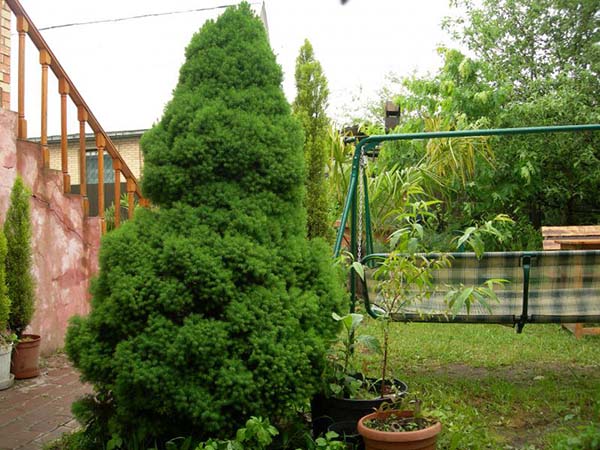
Requirements for growing Canadian Koniki spruce:
- Shine - according to some sources (in different sources they are quite contradictory), photophilous, but easily tolerates partial shade. It grows well in sunny places, but is very prone to sunburn (it will burn on the sunny side without shelter or shading).
It is worth considering! As a rule (according to numerous reviews), Konica grows (behaves, more precisely, feels) in diffused light or penumbra much better than in bright light.
- Moisture - sensitive to drought.
- The soil - does not tolerate soil compaction and waterlogging (moisture stagnation).
- Care and protection - protection from strong winds and from winter and early spring sunlight is required (in other words, it should be covered).
- Frost resistance - very frost-resistant (USDA zone 3 - up to -37.2 ..- 39.9 degrees).
Konik spruce in landscape design
As a rule, Konica is used in landscape design both in single and in group plantings, as well as in flower gardens, mixborders and rock gardens.
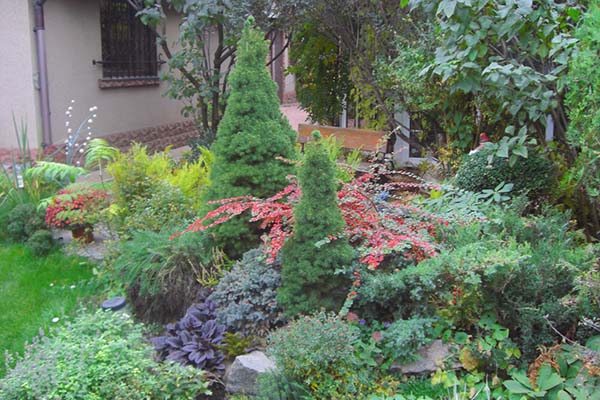
It looks very impressive as a tapeworm (in single plantings) in a dump or on a lawn.
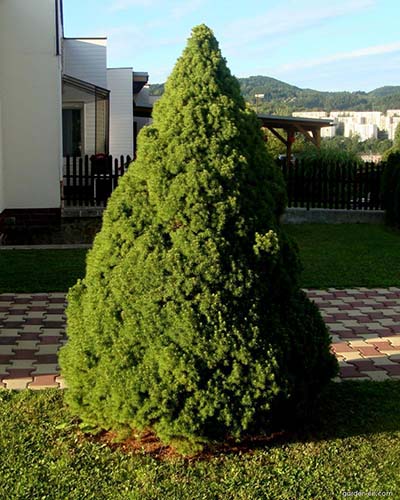
If you decide to make a composition, then it is very beautiful to plant it with other miniature (dwarf) conifers and deciduous plants.
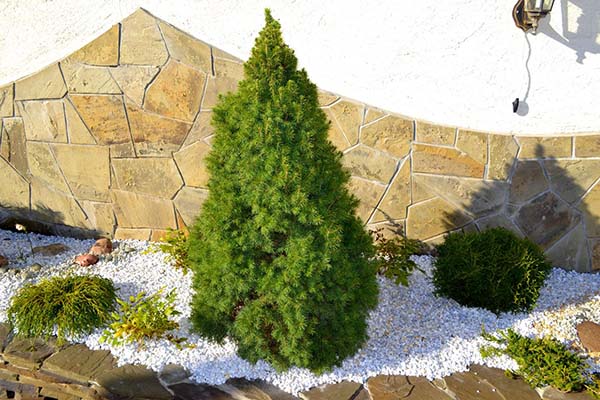
Due to the fact that the plant is relatively slow growing, in principle, it can also be used for container growing.
It should be borne in mind that the Canadian spruce Konica not adapted to urban environment, especially to dirt, in other words, you cannot plant it near the road.
When to plant (transplant) Canadian Konik spruce in open ground: optimal timing
Plant Konika better in spring, so that by winter the spruce is well rooted and strengthened, but planting can be done and in autumn... For example, for the Middle Lane, the approximate planting dates for Koniki spruce in spring are late April-early May, and in autumn - late August-early September.
However, if your autumn is long and warm (you live in the South of Russia), and in spring most often “from boots to sandals”, in other words, heat can quickly come (and a spruce that has not yet taken root will burn in the sun), then it is better to plant Koniku in autumn.
Note! However, container plants can be planted all year round. Nevertheless, the period when young growths are actively beginning to form is considered not too successful.
If you were able to purchase a seedling only in summer, then after planting, you should regularly (once a week) water the young spruce abundantly, pouring out at least 10 liters, and also shallow loosening (5-6 cm).
It is also believed that it is very good to plant conifers. in wintersince at this time of the year, the trees are in complete rest (sleeping), which means they will be less damaged and, accordingly, the adaptation process will be much easier.
Planting Canadian Konik spruce in open ground
The correct planting of Canadian spruce in open ground involves choosing a suitable place for the ephedra soil and an appropriate planting pit.
Drop off location
To plant Konik spruce, you need an area protected from direct sunlight (namely midday) and drying winds, especially on the south side (so that the ephedra does not get burned in spring). In other words, the plant should be located in a semi-shady place your garden (east or north side of the site).
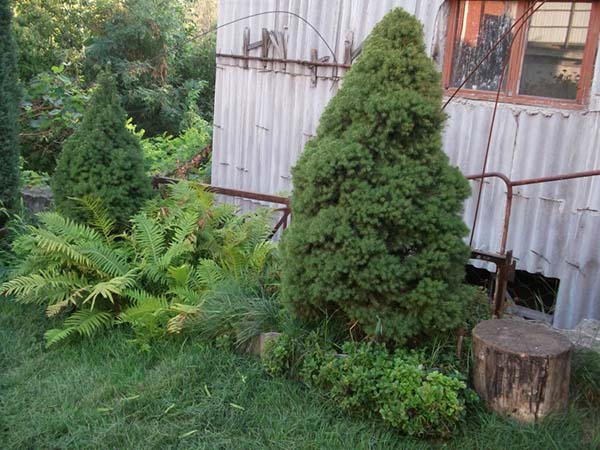
A feature of Koniki is that the spring sun often simply burns the top of the plant, the needles crumble and very rarely recover.
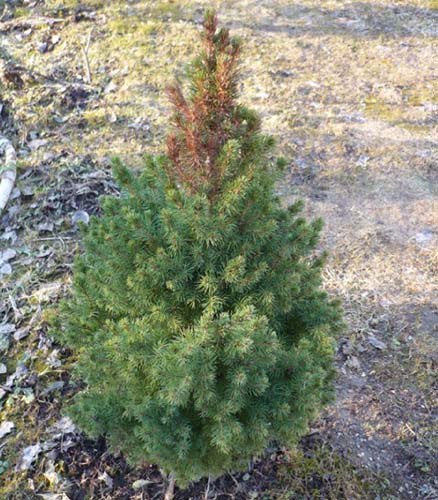
If you have no choice, then Koniku of course can be planted in a sunny place (south or west side of the site), but you will have to water it more often. Also be sure to cover a young seedling for the winter, and not for the purpose of warming, but for the purpose of protection from the spring sun.
Advice! Alternatively, you can cover (shade from the sun) the spruce in January-February special material, through which the sun's rays (ultraviolet radiation) cannot penetrate, for example, spunbond.
Spruce does not like soil compaction and moisture stagnation, which means that near the landing sitee should be nearby groundwater.
However, it should be borne in mind that Konika prefers moist, well-drained soil (optimally - loams).
Landing pit and soil
The size of the planting pit may vary and in the first place depend on the size of the containerfrom which you will transplant a Canadian spruce seedling. Naturally, herself the pit should be larger than the container both in width and depth somewhere in 1.5-2 times. As a rule, the depth of the planting pit is about 50-70 cm, as is the width.
If you plan to plant several seedlings (for example, in a row), then they should be placed at a distance of about 50-70 cm from each other.
To the bottom of the landing pit be sure to pour drainage layer (15-20 cm). To do this, you can use sand, expanded clay, broken brick and other similar materials.
Soil for filling the planting pit you should either purchase it ready-made (for conifers), or prepare it yourself, taking leafy soil, sod land, peat and sand in a ratio of 2: 2: 1: 1. It is best to use high-moor peat and coniferous litter, as well as sand or vermiculite.
Direct landing
Step-by-step instructions for planting Canadian Konik spruce in open ground:
- Water the day before planting so that the earthen lump is better pulled out of the container.
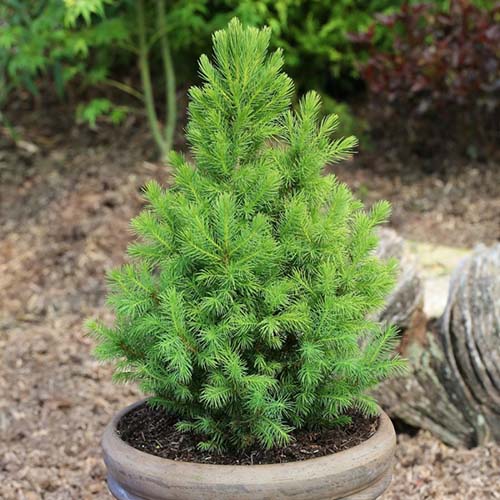
- Choose a suitable location on the site.
- Prepare the planting hole: drain and add some soil mixture.
- Carefully remove the seedling from the container and place it in the prepared hole.
In this case, it is very important that the root collar of the plant is at ground level. In no case should it be buried!
- Sprinkle with plenty of water.
- Add soil if the earth settles and water again.
- To mulch the near-trunk circle with a layer of peat 5-6 cm (in summer - to preserve moisture, and in autumn - to warm the root system).
Video: how to properly plant a Canadian spruce
Features of transplanting Koniki spruce into open ground, bought or donated for the New Year
If you bought or presented you with a Glauka Konik spruce in winter, and you were able to keep it in good condition, then with the onset of spring, when the snow melts, the ephedra should be transplanted into open ground without fail.
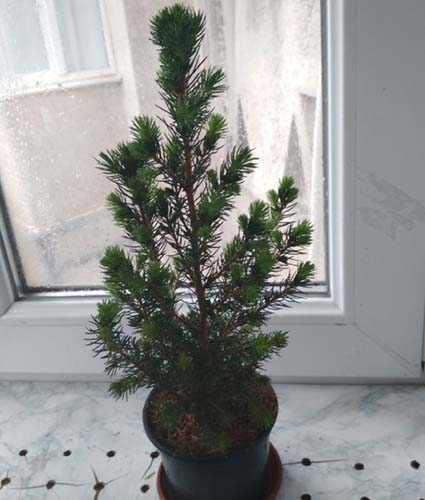
By the way! About, how to care for Konika at home before transplanting into open ground, if you got it (you bought it) in winter, read in this material.
BUT! Where to it is more correct to buy seedlings in spring or autumn, and necessarily in special nurseries or garden centers, not a New Year's sale.
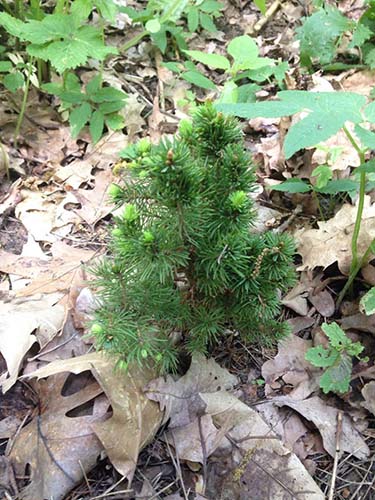
Mandatory actions that are performed when planting Koniki, which you nursed at home, and then transplanted in the spring into open ground:
- With the onset of spring, you should gradually begin to temper Konika, taking it out into fresh air, and preferably not in an open place, but for example, under a canopy. First for 5-10 minutes, then for half an hour, for several hours, and then for the whole day.
- Sprinkle the needles with Epin before and after planting.
- Spill the root system of the plant with a solution of "Kornevin" or "Heteroauxin".
- To mulch the near-trunk circle, and also to cover (shade from the sun) with spruce branches or white cotton cloth (for example, the same gauze) the crown.
- Watering and irrigating the crown must be very careful (preferably with settled water or rainwater), and in the first days almost every day (morning or evening).
Attention! Even if you do everything right, it is not a fact that the plant will accept and take root in the open field (it is especially important that it can survive the winter), because it is already accustomed to indoor conditions.
Worth knowing! The potted buns sold in supermarkets are temporary decorative Christmas trees that are the subject of New Year's commerce and are usually used as disposable plants.
But, of course, there is always a chance to save the plant from death ...
How to care for Canadian Konica spruce outdoors
In order for Konica to be a beautiful, lush and healthy plant, it is worth following some simple care rules.
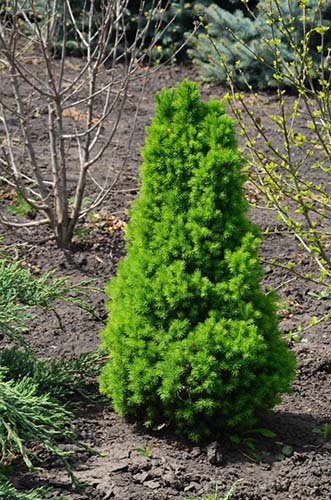
Watering and loosening
Canadian spruce Konica has a relatively shallow root system (the predominant part of the roots is located quite close to the soil surface), therefore, especially in hot weather, it needs frequent and abundant watering (once a week, water consumption of at least 10 liters per young seedling), and in spraying (sprinkling) of the crown. Moreover, after watering, it is desirable to carry out shallow loosening of the soil (by 5-6 cm).
Advice! Every fall a powerfulwater-charging irrigation.
Top dressing
Konik should be fed 2 times per season, using complex fertilizers for conifers. As a rule, this is done in the spring, as well as in the fall to prepare the plant for winter (with phosphorus-potassium fertilizer).
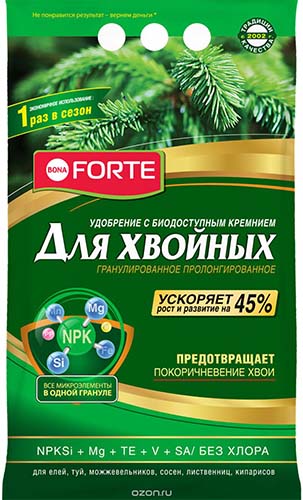
Advice! In the spring, it is highly recommended to alternately spray the needles with a solution of "Epin" and "Zircon", especially if you notice even the slightest burns.
Video: restoration of Koniki spruce after winter (treatment of burns with Epin's solution)
Trimming (cutting and shaping)
As a rule, Canadian spruce is not pruned (and no haircuts are made). But this does not mean that you should not carry out sanitary pruning, getting rid of dry and diseased branches (namely, branches, since if the needles are dry, then it does not follow that the branch is dry - it can be quite alive). Optimally, spruce pruning is carried out in late spring-early summer, when the period of active sap flow ends.
If you want to somehow correct the shape of Koniki, then this can be done by pinching the shoots. So they will branch better and become more luxurious.
Advice! If you want Konica to have one tip, then in the spring you should choose the strongest and most erect shoot, and pinch the side ones (by 1/3 of the growth).
Diseases and pests
Ephedra are very often affected various fungal diseases. In this case, it is necessary to treat spruce with copper-containing preparations (fungicides), for example, "Oxyhom", "Hom" or copper sulfate (1%).
Most often, on the lower shoots, you can find whitemycelium, which indicates the presence of such a fungal disease assnow shute.
If this rust, then you can treat with the drug "Topaz", "Skor".
Note! All spruce treatments from diseases and pests should be carried out repeatedly (according to the instructions).
Konika is very fond of various pests, for example, the same green aphid, spruce-larch shoot moth, spruce spider mite and sawfly (its caterpillars)that live deep in the branches. If your pet has been attacked by pests, then it is necessary to treat, respectively, with insecticides ("Aktara", "Fitoverm", "Confidor", "Iskra", "Fufanon") from specific pests that are difficult, but possible to identify.
Important! If you cover the spruce with pests, then under the shelter it will be more than comfortable and cozy for them to destroy your plant, so in the fall, be sure to carry out eradicating treatments against pests and diseases.
Preparing for winter (shelter)
The main task of preparing Koniki for the winter is its shelter for the winter. Moreover, the purpose of this event is not to insulate the plant (it is already very frost-resistant), but to protect it from sunburn.
Interesting! Many people think that there is no point in sheltering Konika in the fall. It is better to do this in late winter-early spring, because there is nothing to protect it from in winter, the plant can get burns only in February-March, which means that it is necessary to cover it at this time.
So, Konik, growing in a sunny place, i.e. on the south side of the site, you need to cover it annually from burns.
By the way! Alternatively, you can shade the Konik spruce only on one side (south).
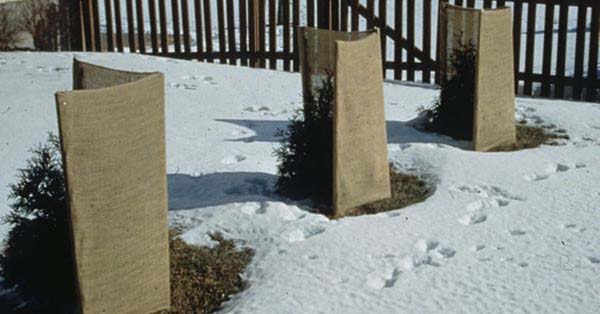
Important! Young conifers in the first 2-3 years after planting are very vulnerable to sunlight, so they should definitely be covered.
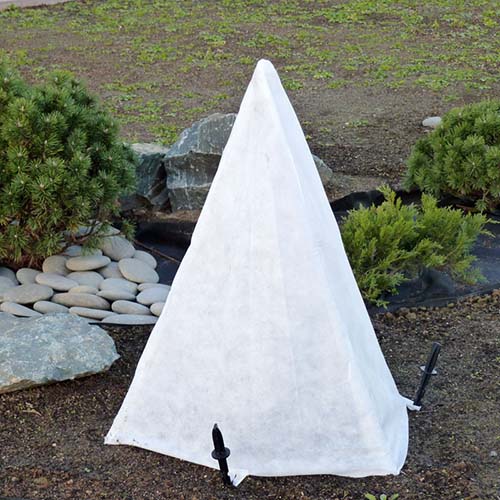
How can you cover Konika for the winter (protect from sunburn):
- white non-woven fabric (spunbond);
In principle, a gray burlap will do.
- special shading net;
To shelter conifers (in particular Canadian spruce) from burns, it is better to choose a mesh with 50% -75% shading. A mesh with a lower percentage of shading should be stacked in several layers.
- white cotton cloth (for example, the same white gauze);
- put on a ready-made cover (sold in stores).
Important! The plant under the shelter must breathe (there must be an influx of air, its circulation), otherwise the ephedra may begin to rot.
For example, in late winter-early spring (February-March), you can throw snow on the plant to the very top. Thus, the ephedra will not only be sheltered from the sun, but when the snow begins to melt, it will gradually receive moisture.
Note! If you planted Konika on the east or north side of the sitethen later (in a year after disembarkation in open ground) morethere will be no need to cover it from burns. But on condition that every autumn a thorough water-charging irrigation will be carried out, and in the spring there will be no sharp temperature drop (i.e. at first there were frosts, and suddenly it became very warm).
Video: Canadian spruce Konica - basic care and preparation for winter
Thus, planting and caring for the Canadian Konik spruce is not so difficult. You just need to know some of the rules for placing a seedling on the site and the requirements for caring for an ornamental coniferous plant. In other words, every gardener, even a beginner, can grow a fluffy beauty with a dense crown of Konik spruce!
Video: Canadian spruce Konica - planting and care


Good day. My Christmas tree has survived until spring and has grown.I do not have a plot, I honestly did not expect that it will last beyond the holidays) it grows well, buds have crawled out, new green twigs have appeared. I want to save her life, is it possible to continue growing it on the balcony, and if so, how to transplant it into a larger pot? If you definitely need to plant it, I'll go to the forest)
Hello! It is for this that the whole calculation is made, that this Christmas tree is purely for the holiday (New Year's holidays), and then throws it out, because it dries out due to inappropriate "dry" and "hot" home conditions.
The plant is really just street, and not home, therefore, of course, it is better to plant it in open ground (in the forest), and preferably in the fall, but if it has become so well accustomed to you and even a new growth has appeared, then you can try to continue growing it at home , there is a separate article on this topic - https://villalux.desigusxpro.com/en/el-konika-glauka-posadka-i-uhod-v-domashnih-usloviyah/
If you are going to transplant into a new pot, then be sure to use the transshipment method (read more in the article).